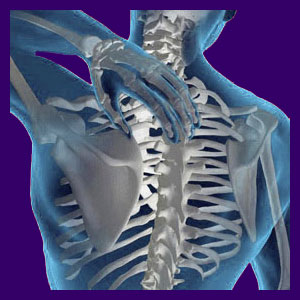
Incorrect upper back pain diagnosis is one of the main reasons why so many treatment options fail, leaving patients wondering how they will deal with chronic thoracic pain potentially for the rest of their lives. As with other dorsopathy syndromes, upper back pain is most commonly diagnosed as stemming from structural spinal abnormalities in the higher thoracic or lower cervical spinal regions. While anatomical issues can certainly cause pain and related neurological symptoms in some cases, many patients are actually suffering from issues which do not show up on spinal MRI diagnostic findings, while the abnormalities which are uncovered, if any, are often coincidental to the pain at hand.
The upper back is generally defined as the region between T1 and T6. This encompasses the area in between the shoulder blades, as well as the base of the neck. Most pain syndromes here are blamed on spinal abnormalities that are located near T1, with fewer structural irregularities being reported as one travels downwards in the upper thoracic spine. Since upper back pain is less prevalent than lumbar or cervical pain syndromes, diagnosis can be a challenging task, especially when no structural abnormalities are present on diagnostic films. However, this might not be a bad thing, as patients might actually benefit by lacking a definitive diagnosis as to the cause of their pain. At least they will not suffer the common fate of misdiagnosis that is so common in the other regions of the spine.
This essay discusses the diagnostic process for upper back pain and the usual problems associated with proper investigative evaluation of upper thoracic dorsalgia.
Upper Back Pain Diagnostic Processing
Most patients will be referred to a specialist for diagnostic evaluation of a persistent upper dorsalgia problem. Usually, this involves a physical exam (although this crucial step is often downplayed or completely overlooked) and spinal imaging using x-ray, CT scan or MRI. Once the spine is visualized, most doctors will virtually always look for structural abnormalities and then blame these abnormalities as being the cause of pain. Rarely will doctors (especially non-neurologists) seek to correlate symptoms or verify any pathological component to the imaged structural irregularities. It is usually more the case of “Oh, there is something different here, so this must be the cause of your pain”. I guess that these doctors never studied the universally-embraced medical lesson that “atypical structure almost never predicts pain”.
Assuming that some anatomically-different issue is located on the diagnostic imaging (bulging discs, facet joint deterioration and general osteoarthritis are virtually universal near T1), the patient will likely be placed into treatment targeting these conditions.
If the imaging does not reveal any structural spinal concerns, then things get more interesting. Some patients will be studied objectively and possibly labeled with an enlightened diagnosis based on verifiable evidence of non-spinal pathology. This might be some muscular issue, RSI condition, or thoracic outlet syndrome. Others will be arbitrarily labeled with far less enlightened verdicts (such as muscle imbalances) without the benefit of evidence supporting the diagnosis. Some patients will not receive any diagnosis at all and these are the most interesting cases of all, as detailed in the section immediately below.
Lacking a Diagnosis?
Some doctors are hesitant to blame basically normal age and activity-related spinal or nonspinal changes for causing pain without proof of pathology. Since this proof is virtually always lacking when structural abnormalities are present, the patients might not receive any diagnosis at all. They are labeled as suffering from idiopathic back pain. This can be frustrating and even infuriating to patients, but in our many years of research study and clinical practice, we have found something very interesting and unexpected in this patient population.
Patients who do not receive a definitive diagnosis generally recover faster and more completely than those who do receive a diagnosis placing blame on a specific structural problem. This is true regardless of whether patients choose to enter treatment or not. This occurrence is easily explained by the lack of powerful nocebo effect imparted on these patients, while their positively diagnosed brethren are not so fortunate in this regard. We have also discovered that similar improvements in back pain outcomes result when patients choose to forgo medical care, regardless of the nature of their diagnosis or lack of a diagnosis. These statistics really makes one worry about the sad state of the current back pain treatment sector when patients who receive “no treatment” fare much better than patients who receive ANY specific type of treatment. Over the past 10 years, we have witnessed these trends growing, demonstrating that the diagnostic and treatment processes must be inherently flawed in many ways. This is one of our main motivations for constant critique of the epidemic of iatrogenic error perpetrated against so many dorsalgia sufferers.
Upper Back Pain Misdiagnosis
Misdiagnosed back pain is a literal epidemic within the larger dorsalgia treatment sector. Showing a diagnostic imaging study to 4 different doctors may just net a patient 4 distinct opinions on the exact source of pain. This is called diagnostic eclecticism and is part of the problem with how dorsopathy is managed in the chronic pain industry. In few scenarios will the diagnosis be accurate and enlightened; leading to successful treatment and permanent resolution of the symptoms. In a far larger number of cases, the actual source of upper pain will not be found; leading the patient on an impossible quest for relief treating incorrectly identified structural issues which are innocent of blame or simply using symptomatic treatment to help cope with an undefined origin of pain. This helps explain why so few conservative and surgical interventions actually permanently cure back pain.
Do not simply and blindly trust that you diagnosis is correct. Doing so will put you on the path to potential disaster. This I know for sure, since it took me years to question my diagnosis, dooming me to seemingly endless suffering while many different doctors and therapists got rich at my expense. Instead, do some independent research about your diagnosis. We always recommend that patients compare the expected symptoms to the clinical presentation and look carefully for any discrepancies. Often the symptoms are far too widespread to be accounted for based on the diagnosis made. This occurs to doctors, as well, but most will stand their ground, since no other explanation is available to them given their limited training in non-structural symptomatic causations and structural sources of pain that can not be imaged.
Why wait until you have already tried everything and all the treatments fail? Do not make the same mistake that millions of others do. Get ahead of the game by learning about your condition now and trying to recognize the potential for misdiagnosis earlier, rather than later.
If your pain was correctly linked to a structural cause, then consider yourself lucky, even if it means undergoing surgery. You are certainly in the minority of patients who have actually received accurate diagnostic conclusions, as statistics clearly reveal. However, if you have already tried several different therapy options for finding back pain relief without success, it is time to consider the obvious: Maybe that diagnosis is not so accurate after all.





